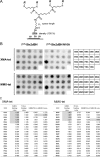Affinity-Based Screening of Tetravalent Peptides Identifies Subtype-Selective Neutralizers of Shiga Toxin 2d, a Highly Virulent Subtype, by Targeting a Unique Amino Acid Involved in Its Receptor Recognition
- PMID: 27382021
- PMCID: PMC4995913
- DOI: 10.1128/IAI.00149-16
Affinity-Based Screening of Tetravalent Peptides Identifies Subtype-Selective Neutralizers of Shiga Toxin 2d, a Highly Virulent Subtype, by Targeting a Unique Amino Acid Involved in Its Receptor Recognition
Abstract
Shiga toxin (Stx), a major virulence factor of enterohemorrhagic Escherichia coli (EHEC), can be classified into two subgroups, Stx1 and Stx2, each consisting of various closely related subtypes. Stx2 subtypes Stx2a and Stx2d are highly virulent and linked with serious human disorders, such as acute encephalopathy and hemolytic-uremic syndrome. Through affinity-based screening of a tetravalent peptide library, we previously developed peptide neutralizers of Stx2a in which the structure was optimized to bind to the B-subunit pentamer. In this study, we identified Stx2d-selective neutralizers by targeting Asn16 of the B subunit, an amino acid unique to Stx2d that plays an essential role in receptor binding. We synthesized a series of tetravalent peptides on a cellulose membrane in which the core structure was exactly the same as that of peptides in the tetravalent library. A total of nine candidate motifs were selected to synthesize tetravalent forms of the peptides by screening two series of the tetravalent peptides. Five of the tetravalent peptides effectively inhibited the cytotoxicity of Stx2a and Stx2d, and notably, two of the peptides selectively inhibited Stx2d. These two tetravalent peptides bound to the Stx2d B subunit with high affinity dependent on Asn16. The mechanism of binding to the Stx2d B subunit differed from that of binding to Stx2a in that the peptides covered a relatively wide region of the receptor-binding surface. Thus, this highly optimized screening technique enables the development of subtype-selective neutralizers, which may lead to more sophisticated treatments of infections by Stx-producing EHEC.
Copyright © 2016, American Society for Microbiology. All Rights Reserved.
Figures



Similar articles
-
Switching Shiga Toxin (Stx) Type from Stx2d to Stx2a but Not Stx2c Alters Virulence of Stx-Producing Escherichia coli (STEC) Strain B2F1 in Streptomycin (Str)-Treated Mice.Toxins (Basel). 2021 Jan 15;13(1):64. doi: 10.3390/toxins13010064. Toxins (Basel). 2021. PMID: 33467588 Free PMC article.
-
Identification of a wide range of motifs inhibitory to shiga toxin by affinity-driven screening of customized divalent peptides synthesized on a membrane.Appl Environ Microbiol. 2015 Feb;81(3):1092-100. doi: 10.1128/AEM.03517-14. Epub 2014 Dec 1. Appl Environ Microbiol. 2015. PMID: 25452283 Free PMC article.
-
Activation of Shiga toxin type 2d (Stx2d) by elastase involves cleavage of the C-terminal two amino acids of the A2 peptide in the context of the appropriate B pentamer.Mol Microbiol. 2002 Jan;43(1):207-15. doi: 10.1046/j.1365-2958.2002.02733.x. Mol Microbiol. 2002. PMID: 11849548
-
Identification of a peptide-based neutralizer that potently inhibits both Shiga toxins 1 and 2 by targeting specific receptor-binding regions.Infect Immun. 2013 Jun;81(6):2133-8. doi: 10.1128/IAI.01256-12. Epub 2013 Apr 1. Infect Immun. 2013. PMID: 23545297 Free PMC article.
-
Recent progress of Shiga toxin neutralizer for treatment of infections by Shiga toxin-producing Escherichia coli.Arch Immunol Ther Exp (Warsz). 2011 Aug;59(4):239-47. doi: 10.1007/s00005-011-0130-5. Epub 2011 Jun 5. Arch Immunol Ther Exp (Warsz). 2011. PMID: 21644029 Review.
Cited by
-
Shiga Toxin Therapeutics: Beyond Neutralization.Toxins (Basel). 2017 Sep 19;9(9):291. doi: 10.3390/toxins9090291. Toxins (Basel). 2017. PMID: 28925976 Free PMC article. Review.
-
Identification of a peptide motif that potently inhibits two functionally distinct subunits of Shiga toxin.Commun Biol. 2021 May 10;4(1):538. doi: 10.1038/s42003-021-02068-3. Commun Biol. 2021. PMID: 33972673 Free PMC article.
-
CaMKII-dependent non-canonical RIG-I pathway promotes influenza virus propagation in the acute-phase of infection.mBio. 2025 Jan 8;16(1):e0008724. doi: 10.1128/mbio.00087-24. Epub 2024 Nov 27. mBio. 2025. PMID: 39601535 Free PMC article.
-
A tailored tetravalent peptide displays dual functions to inhibit amyloid β production and aggregation.Commun Biol. 2023 Apr 8;6(1):383. doi: 10.1038/s42003-023-04771-9. Commun Biol. 2023. PMID: 37031306 Free PMC article.
-
The inducible amphisome isolates viral hemagglutinin and defends against influenza A virus infection.Nat Commun. 2020 Jan 9;11(1):162. doi: 10.1038/s41467-019-13974-w. Nat Commun. 2020. PMID: 31919357 Free PMC article.
References
-
- Karmali MA, Steele BT, Petric M, Lim C. 1983. Sporadic cases of hemolytic uremic syndrome associated with fecal cytotoxin and cytotoxin-producing Escherichia coli. Lancet i:619–620. - PubMed
-
- Tarr PI, Gordon CA, Chandler WL. 2005. Shiga-toxin-producing Escherichia coli and haemolytic uraemic syndrome. Lancet 365:1073–1086. - PubMed
Publication types
MeSH terms
Substances
LinkOut - more resources
Full Text Sources
Other Literature Sources

